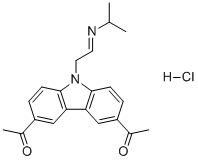CBL0137 HCl
This product is for research use only, not for human use. We do not sell to patients.

For small sizes, please check our retail website as below: www.invivochem.com
| Size | Price | Stock |
|---|---|---|
| 250mg | $1100 | Check With Us |
| 500mg | $1800 | Check With Us |
| 1g | $2700 | Check With Us |
Cat #: V3173 CAS #: 1197397-89-9 Purity ≥ 98%
Description: CBL0137 HCl, the hydrochloride salt of CBL-0137 (formerly Curaxin 137 or CBL 0137), is an inhibitor of the histone chaperone, FACT (facilitates chromatin transcription complex).
Top Publications Citing Invivochem Products
Publications Citing InvivoChem Products
Product Promise

- Physicochemical and Storage Information
- Protocol
- Related Biological Data
- Stock Solution Preparation
- Quality Control Documentation
| Molecular Weight (MW) | 372.89 |
|---|---|
| Molecular Formula | C21H24N2O2-HCl |
| CAS No. | 1197397-89-9 |
| Storage | -20℃ for 3 years in powder formr |
| -80℃ for 2 years in solvent | |
| Solubility In Vitro | DMSO: >35 mg/mLr |
| Water: >20 mg/mLr | |
| Ethanol: < 1 mg/mL | |
| SMILES Code | CC(NCCN1C2=C(C3=C1C=CC(C(C)=O)=C3)C=C(C(C)=O)C=C2)C.[H]Cl |
| Synonyms | CBL 0137 HCl; CBL-0137 HCl; CBL0137 HCl; Curaxin 137 HCl |
| Protocol | In Vitro | Treatment with CBL0137 hydrochloride leads to complete absence of living cells at concentrations above 2.5 μM. CBL0137 hydrochloride causes a greater reduction in the number of colonies formed of not only MiaPaCa-2 cells when combines with gemcitabine, but also gemcitabine-resistant PANC-1 cells. Treatment of human pancreatic cancer cells with CBL0137 hydrochloride results in a dose dependent reduction of protein and mRNA levels of RRM1 and RRM2. |
|---|---|---|
| In Vivo | The CBL0137 hydrochloride monotherapy group and the CBL0137 hydrochloride-gemcitabine combination group samples show large necrotic fields, numerous apoptotic bodies and loss of tumor cells. Sub-optimal doses of 50 to 60 mg/kg CBL0137 hydrochloride causes similar enhancement of gemcitabine antitumor activity as that produced by the maximum tolerated dose (MTD) of 90 mg/kg as indicated by the lack of statistically significant differences among the combination groups. CBL0137 hydrochloride inhibits FACT function through depletion of the pool of active FACT involved in transcription elongation. | |
| Animal model | 10-week old female athymic nude mice |
These protocols are for reference only. InvivoChem does not
independently validate these methods.
| Solvent volume to be added | Mass (the weight of a compound) | |||
|---|---|---|---|---|
| Mother liquor concentration | 1mg | 5mg | 10mg | 20mg |
| 1mM | 2.6818 mL | 13.4088 mL | 26.8176 mL | 53.6351 mL |
| 5mM | 0.5364 mL | 2.6818 mL | 5.3635 mL | 10.7270 mL |
| 10mM | 0.2682 mL | 1.3409 mL | 2.6818 mL | 5.3635 mL |
| 20mM | 0.1341 mL | 0.6704 mL | 1.3409 mL | 2.6818 mL |
The molarity calculator equation
Mass(g) = Concentration(mol/L) × Volume(L) × Molecular Weight(g/mol)
Mass
=
Concentration
×
Volume
×
Molecular Weight*
The dilution calculator equation
Concentration(start)
×
Volume(start)
=
Concentration(final)
×
Volume(final)
This equation is commonly abbreviated as: C1 V1 = C2 V2
Concentration(start)
C1
×
Volume(start)
V1
=
Concentration(final)
C2
×
Volume(final)
V2
Step One: Enter information below
Dosage mg/kg
Average weight of animals g
Dosing volume per animal µL
Number of animals
Step Two: Enter the in vivo formulation
%DMSO
+
%
+
%Tween 80
+
%ddH2O
Calculation Results:
Working concentration:
mg/ml;
Method for preparing DMSO master liquid:
mg
drug pre-dissolved in
µL
DMSO(Master liquid concentration
mg/mL)
,Please contact us first if the concentration exceeds the DMSO solubility of the batch of drug.
Method for preparing in vivo formulation:
Take
µL
DMSO master liquid, next add
µL
PEG300, mix and clarify, next add
µL
Tween 80,mix and clarify, next add
µL
ddH2O,mix and clarify.
Note:
- (1) Please be sure that the solution is clear before the addition of next solvent. Dissolution methods like vortex, ultrasound or warming and heat may be used to aid dissolving.
- (2) Be sure to add the solvent(s) in order.




































